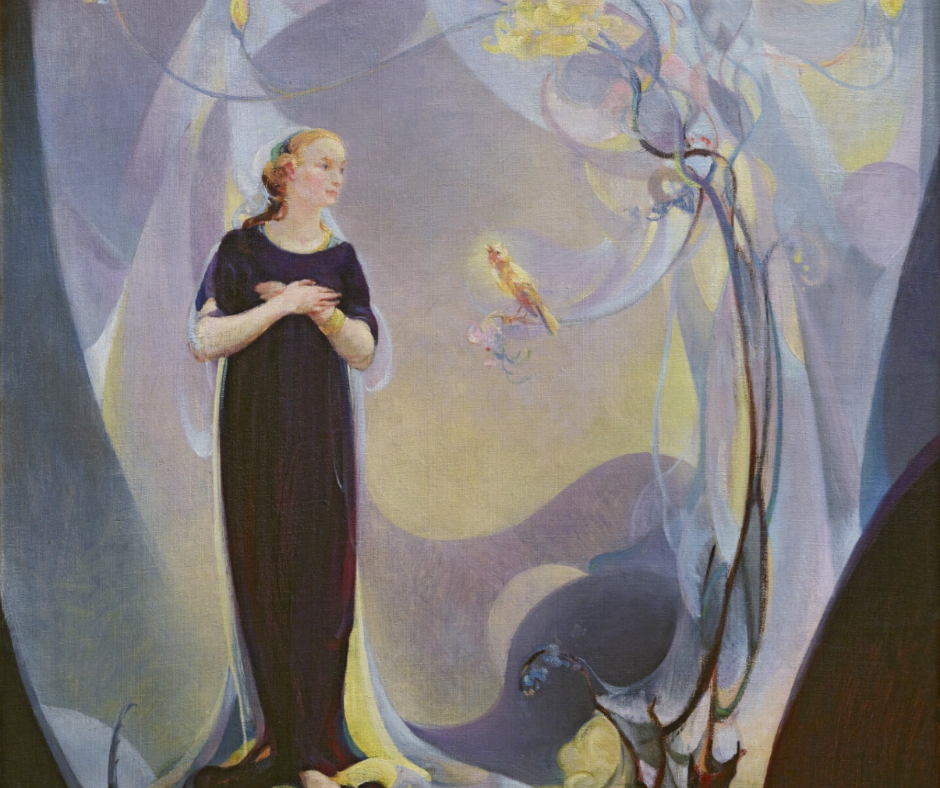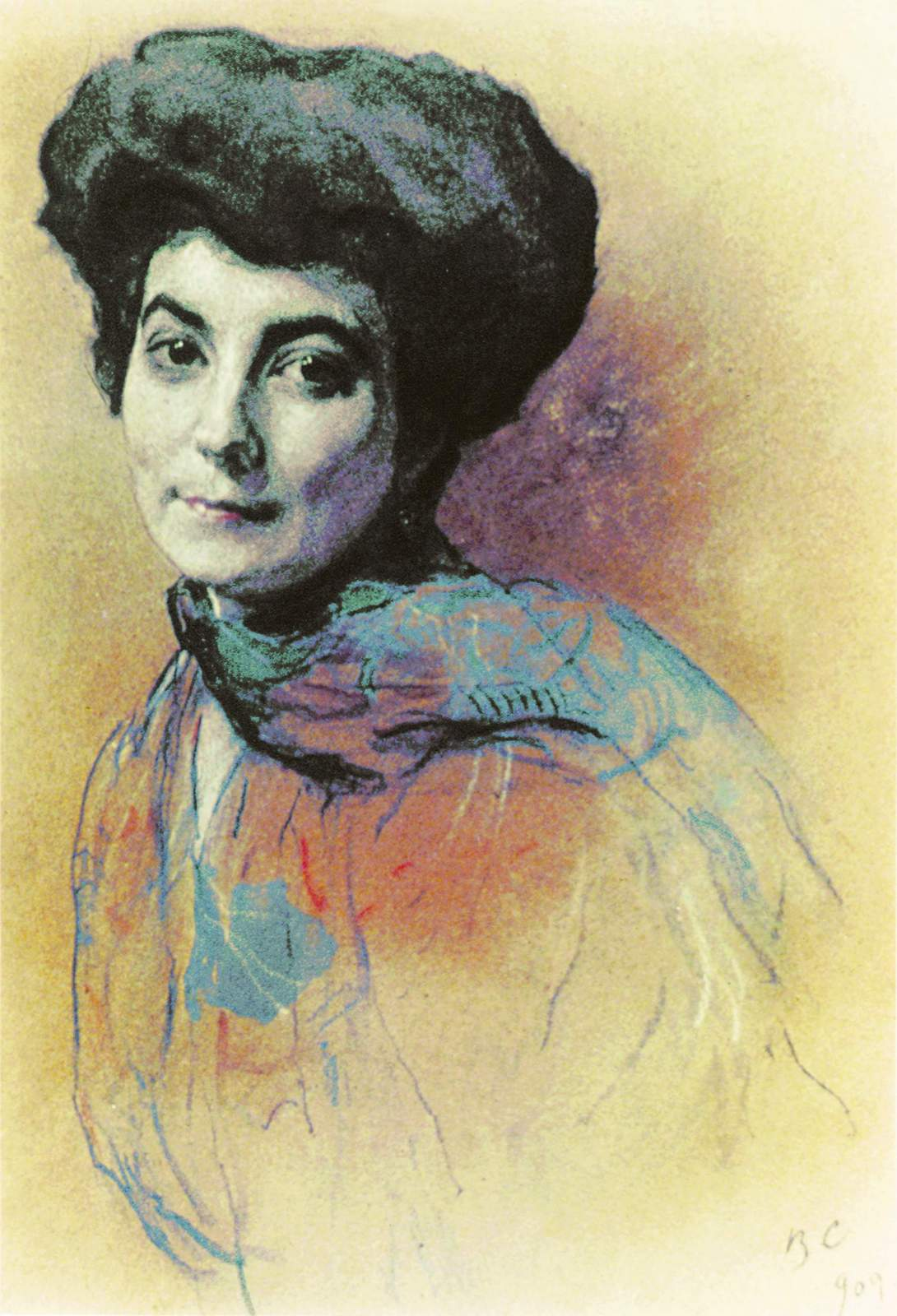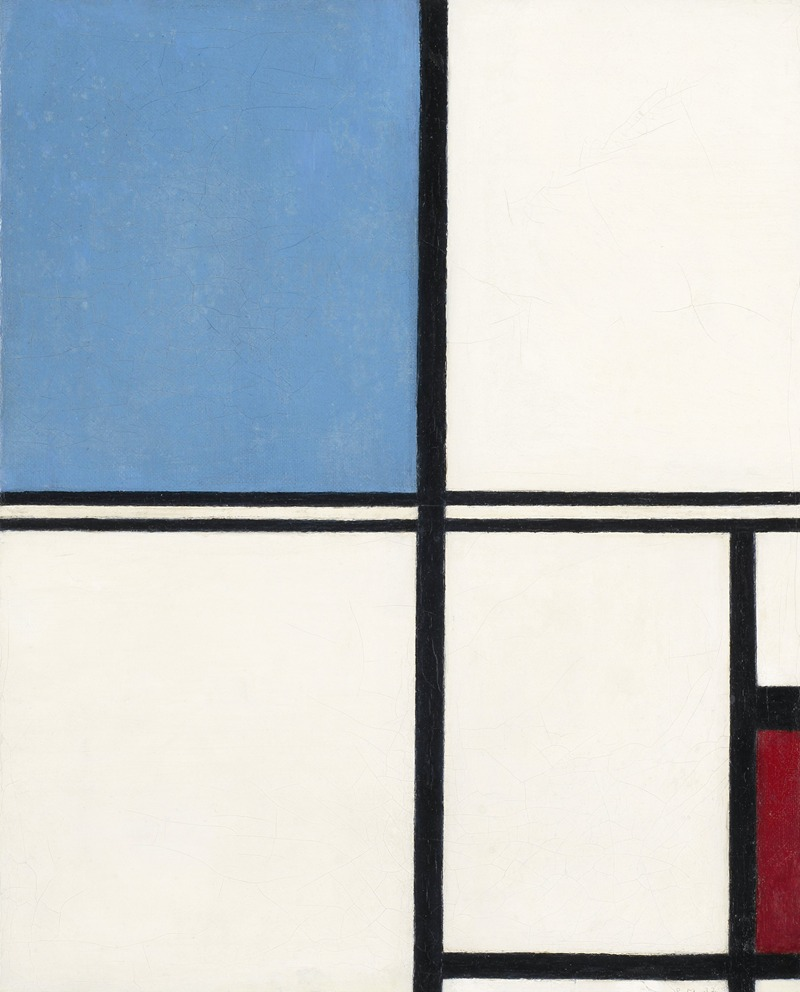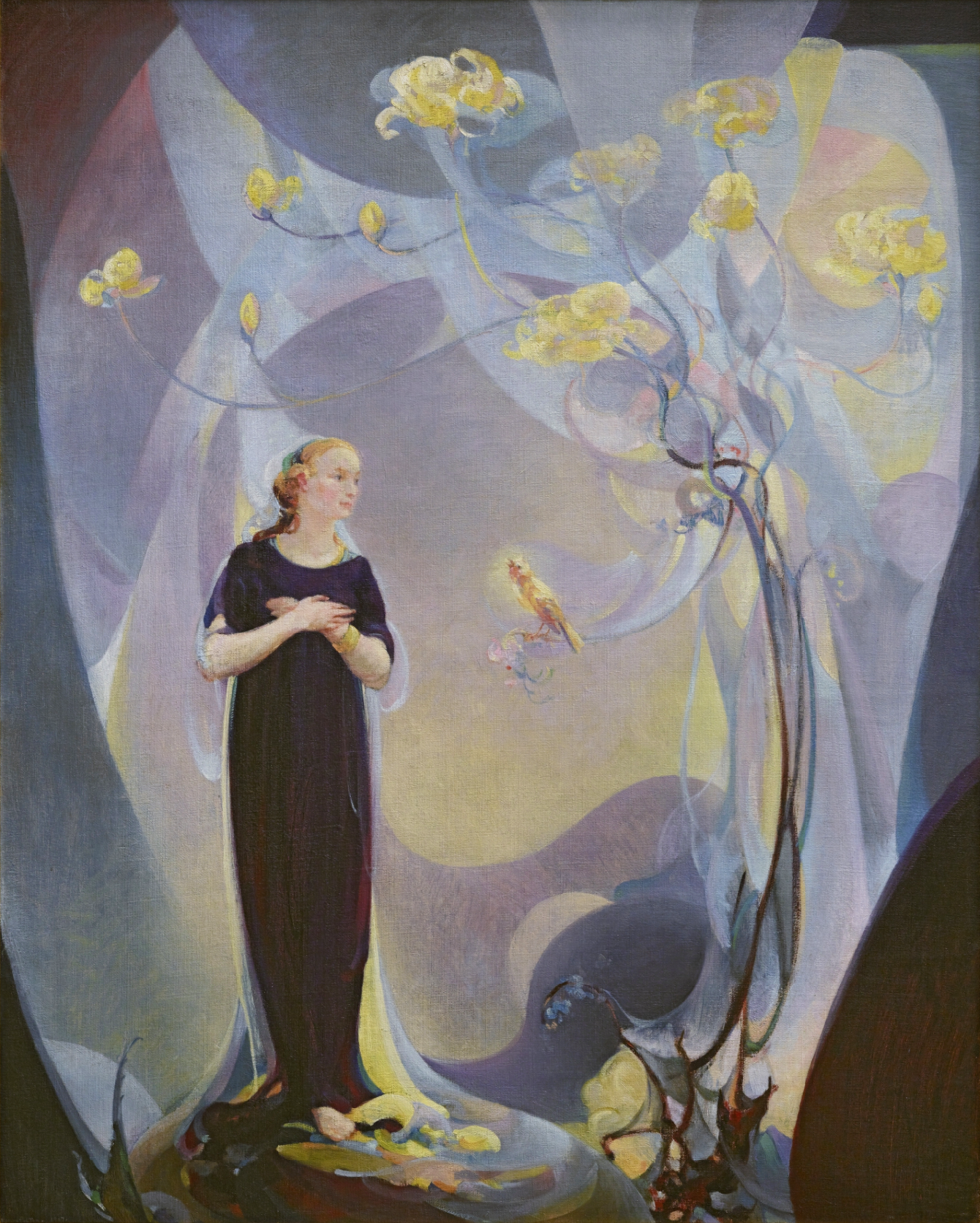

A Spiritual Call for Art: All About American Modernist Agnes Pelton
Summary
Reflection Questions
Journal Prompt
The work of Agnes Pelton, characterized by a blend of abstract forms and spiritual themes, set her apart from her early 20th century contemporaries. Pelton’s contribution to the art world is notable for its fusion of abstract art with deep spiritual underpinnings. Her paintings often feature soft, delicate shapes and a serene palette, reflecting her interest in spirituality and the metaphysical.
In a review of an Agnes Pelton exhibition at the Whitney for Artnet, Ben Davis wrote that “As much as Agnes Pelton’s art answered a spiritual call and an inner necessity, she also was a trained artist and brought an artist’s instinct for formal freshness to her quiet desert studio.” Her search for meaning and her ability to capture that quest in color, form, and light are what made Pelton such a dazzling artist.
Ethereal and luminous, her paintings are some of the most striking to emerge during the American Modernist movement. Once overshadowed, her work is now being appreciated for its visionary blend of abstraction and spirituality. Let’s journey through her life, work, and recent rediscovery.
Agnes Pelton’s Upbringing and Initial Artistic Exposure
Agnes Pelton was born in 1881 in Stuttgart, Germany, to American parents. Her family returned to the United States during her childhood, settling in Brooklyn, New York. This transatlantic upbringing in the late 19th century exposed Pelton to a variety of cultural influences from a young age.
Her family was supportive of her artistic inclinations, fostering a creative environment that nurtured her developing talents. The loss of her father when she was just nine years old had a profound impact on her, deepening her introspective nature and sensitivity, traits that would later be reflected in her art.
Education and Early Influences
Pelton’s formal artistic education began at the Pratt Institute in Brooklyn, where she studied from 1895 to 1900. Here, she was exposed to the prevailing artistic trends of the time, initially adopting a more realistic and impressionistic style.
Influenced by her teachers and the artistic milieu of the turn of the century, Pelton’s early work reflects a keen observation of the natural world, a theme that would remain central to her work even as her style evolved. Her exposure to European modernism, particularly during a study trip to Italy, played a crucial role in her artistic development, laying the groundwork for her later experimentation with abstract forms.
Transition to Abstract Art


Pelton’s shift towards abstract art was gradual and influenced by her personal journey and the broader cultural shifts of the early 20th century. Her move to Long Island and later to the desert of California coincided with a deepening interest in spiritualism and esoteric philosophies, notably Theosophy and Agni Yoga. These philosophies, which sought to explore the mystical and unseen aspects of the world, resonated with Pelton and profoundly influenced her artistic direction.
Her work began to transcend traditional forms, embracing a more abstract and symbolic language that sought to capture the spiritual and transcendent realms. This transition marked Pelton’s departure from conventional realism to a unique form of expression that would define her contribution to modern art.
Pelton’s Artistic Style and Philosophy
Agnes Pelton’s evolution from traditional impressionistic styles to a distinctive form of abstract and symbolic painting was marked by gradual experimentation and personal exploration. Her transition, which took place in the early 20th century, mirrored a broader movement within the art world towards abstraction.
Pelton’s abstract works are characterized by their use of soft, luminous shapes and a gentle, often pastel color palette. Unlike the more angular and disjointed forms seen in the works of some of her contemporaries, Pelton’s abstractions leaned towards fluid, organic shapes, suggesting a more introspective and meditative approach to abstraction. This signature style set her apart, creating a visual language that was both deeply personal and universally resonant.
Influence of Spiritualism and Mysticism
Pelton’s art was profoundly influenced by her engagement with spiritualism and mysticism, particularly Theosophy and Agni Yoga. These spiritual movements, which gained popularity in the late 19th and early 20th centuries, emphasized a deeper understanding of the metaphysical world and the inner self.
Theosophy’s blend of Eastern and Western spiritual ideas and Agni Yoga’s focus on inner enlightenment and higher consciousness found a visual echo in Pelton’s work. Her paintings began to represent not just the physical world, but an attempt to capture the essence of spiritual experiences and metaphysical realities. This spiritual dimension added a layer of depth and meaning to her abstract forms, setting her work apart in the realm of American Modernism.
Key Themes and Subjects
In Pelton’s body of work, several recurring themes and symbols stand out, reflecting her spiritual and philosophical interests. Light, in particular, is a dominant motif, often represented as a glowing orb or radiating forms, symbolizing enlightenment, energy, and the metaphysical. Natural elements like flowers and landscapes are abstracted but still recognizable, pointing to her ongoing fascination with the natural world as a source of spiritual inspiration.
Another key theme is the exploration of the balance between the tangible and intangible, the seen and unseen, which she navigated through a delicate interplay of form, color, and light. These motifs collectively underscore Pelton’s pursuit to express the inexpressible – the spiritual and mystical realms beyond the physical world.
Her Materials and Approach to Painting
Pelton’s technique was characterized by her masterful use of layered oil paints, her ethereal color palette, delicate brushwork, and her ability to imbue her paintings with a sense of inner light and spiritual depth. This combination of materials and methods resulted in a body of work that was both visually striking and rich in symbolic meaning. Let’s explore her technique in further detail.
Layering and Texture
Pelton often used thin layers of oil paint, building them up gradually to create a sense of depth and luminosity. This layering technique allowed light to penetrate through the layers and reflect back, giving her paintings a characteristic inner glow. She was skilled in manipulating the opacity and transparency of her oils, which added a dreamlike quality to her works.
Color Palette
Her choice of colors was generally soft and often pastel, which contributed to the ethereal and tranquil feel of her paintings. Pelton’s palette tended to include a lot of whites, blues, soft yellows, and pinks. These colors were carefully chosen to evoke the spiritual and mystical themes she was interested in.
Brushwork
Pelton’s brushwork varied depending on the effect she was trying to achieve. She could use smooth, almost imperceptible brushstrokes to create serene, untroubled surfaces, or more expressive strokes when depicting elements of the natural world. Her control of the brush allowed her to create forms that were both precise and fluid.
Use of Light
One of the most notable aspects of her technique was her treatment of light. She often depicted light sources within her paintings that radiated or glowed, contributing to the spiritual ambiance of her work. This effect was achieved through careful layering and blending of colors.
Composition
In terms of composition, Pelton’s paintings were carefully balanced, with a keen sense of the placement of forms and elements within the pictorial space. Even in her more abstract works, there was a sense of harmony and order.
Pelton’s Involvement in the Modernist Movement
Agnes Pelton’s role in the American Modernist movement is a study in contrasts. While she was contemporaneous with and shared certain philosophies with other Modernist artists, she often remained on the periphery of the movement in terms of recognition and influence during her lifetime. Her work, deeply personal and introspective, differed from the more overtly political and social themes that many of her contemporaries engaged with.
However, her exploration of abstraction and symbolism places her firmly within the Modernist canon. Pelton’s approach to Modernism was less about breaking with tradition for its own sake and more about exploring the inner realms and spiritual experiences through her art. This makes her an important, if understated, figure within the movement, offering a unique interpretation of Modernism’s broader goals.
Participation in the Transcendental Painting Group
Pelton’s involvement with the Transcendental Painting Group (TPG) was a significant aspect of her career. Founded in 1938 in New Mexico, the TPG was a collective of artists who aimed to convey spiritual and mystical themes through abstract art. As a member, Pelton found a like-minded community that shared her belief in the power of art to express transcendent realities.
Her contributions to the group were marked by her distinctive style and deep commitment to its philosophical underpinnings. Through the TPG, Pelton and her peers sought to elevate abstract art beyond mere aesthetic innovation, using it as a tool to explore and express metaphysical and spiritual concepts.
Comparison with Peers


Compared to her Modernist peers, Pelton’s work was distinctive in its quiet introspection and spiritual depth. While many Modernist artists were exploring abstraction as a response to the rapid changes of the 20th century, Pelton’s approach was more reflective, turning inward to explore the mystical and ethereal.
Unlike the bold, often geometric abstraction of artists like Piet Mondrian or the surrealism of Salvador Dali, Pelton’s abstraction was softer, more fluid, and imbued with a sense of serenity. Her use of light, form, and color was less about challenging viewers’ perceptions and more about inviting them into a contemplative space. This unique approach set her apart from her contemporaries, providing a more introspective and spiritually oriented perspective within the Modernist movement.
Her work could be tied more directly to that of Georgia O’Keeffe, who was also influenced by the desert landscapes of her later home.
Agnes Pelton’s Major Works and Exhibitions
Among Agnes Pelton’s notable works, several stand out for their representation of her unique style and spiritual themes. “Ahmi in Egypt” (1931) is one such painting, where she merges abstract forms with a mystical sensibility, reflecting her interest in ancient civilizations and spiritual journeys. Another significant work, “Orbits” (1934), showcases her use of light and ethereal forms to explore metaphysical concepts.
“The Voice” (1930) and “Messengers” (1932) are also key paintings in her oeuvre, demonstrating her skill in blending abstract elements with a sense of the sublime. These works collectively exemplify Pelton’s ability to convey deep spiritual and introspective themes through a distinct visual language.
Solo and Group Exhibitions
During her lifetime, Pelton’s participation in exhibitions was limited but significant. She exhibited with the Transcendental Painting Group, which she joined in 1938, and had solo exhibitions in various locations, including New York and California. Her work was also included in group shows, such as the 1939 Golden Gate International Exposition in San Francisco. However, her exhibitions did not gain the same level of attention as some of her contemporaries, and as a result, her influence during her lifetime was more muted compared to her posthumous recognition.
Posthumous Recognition
Pelton’s work has seen a resurgence of interest in recent years, leading to major retrospectives and exhibitions. One of the most notable was at the Whitney Museum of American Art in New York in 2020, which significantly elevated her profile in the art world.
This retrospective, titled “Agnes Pelton: Desert Transcendentalist,” showcased a broad range of her work and highlighted her contributions to American Modernism. Other exhibitions across various art institutions have followed, bringing her ethereal and introspective paintings to a new audience and solidifying her place as a significant figure in early 20th-century American art.
Her Later Life and Enduring Legacy
In her later years, Agnes Pelton settled in Cathedral City, California, a location that profoundly influenced her artistic output. The desert landscape, with its expansive skies and unique light, provided a backdrop that deeply resonated with her spiritual and artistic sensibilities. It was here that the desert landscape profoundly influenced her thematic and stylistic directions.
During this period, Pelton continued to produce art, though her work remained largely outside the mainstream art scene. Her paintings from this time reflect a deepening of her exploration into abstract forms and spiritual themes. Living a relatively solitary life, Pelton dedicated herself to her art, creating works that continued to evolve in style and depth, marking this period as a significant phase in her artistic journey.
Impact on Future Generations
The influence of Pelton’s work on contemporary artists and movements has become more apparent with the growing interest in her art. Her approach to abstraction, imbued with spiritual and introspective qualities, offers a different perspective within the Modernist canon.
Contemporary artists, particularly those exploring spiritual and mystical themes, find inspiration in Pelton’s ability to convey deep metaphysical concepts through abstract forms. Her work is increasingly seen as a precursor to certain aspects of contemporary abstract and symbolic art, highlighting her role in the broader narrative of American Modernism.
Recent Resurgence and Current Status in the Art World
The recent surge in interest and reevaluation of Agnes Pelton’s work marks a significant shift in her posthumous recognition. This rediscovery is part of a broader trend in the art world to reexamine and celebrate previously overlooked artists, particularly women.
Her exhibitions in prominent museums and galleries have introduced her work to a new audience, leading to a reassessment of her contributions to the Modernist movement. Today, Pelton is celebrated not only for her unique artistic vision but also as an important figure in the narrative of American art, whose work bridges the realms of abstraction and spiritual exploration.
“Rediscovery” of Female Artists in Modernism
The narrative of Pelton’s recent rediscovery is reflective of a larger trend in the art world, where many female artists who contributed significantly to the Modernist movement were historically ignored or marginalized. For decades, the art historical narrative was predominantly focused on male artists, leading to the underrepresentation and undervaluation of women’s contributions.
However, in recent years, there has been a concerted effort to “rediscover” and reevaluate the work of these women, bringing their contributions to light. This shift is not only about correcting historical oversights but also about enriching our understanding of Modernism and its diverse voices. By acknowledging and celebrating these artists, the art world is expanding its perspective and giving deserved recognition to a more inclusive range of influential figures.
Final Thoughts on the Life and Work of Agnes Pelton


Agnes Pelton’s contributions to art and the Modernist movement, marked by her unique fusion of abstraction and spiritual exploration, have only recently begun to receive the recognition they deserve. Her ethereal, introspective canvases, once overshadowed in the male-dominated art world, now shine as testaments to her visionary approach.
The growing appreciation of Pelton’s work in contemporary art circles is a heartening sign of the art world’s evolving inclusivity and its efforts to correct historical oversights. Her legacy, a blend of mysticism and modernist abstraction, continues to resonate, offering fresh perspectives and inspiration in modern art history.
As we acknowledge Pelton’s rightful place in the artistic canon, we encourage women in creative fields today to actively advocate for the recognition of other women in the arts. Pelton’s journey from obscurity to posthumous fame serves as a powerful reminder of the need to seek out and celebrate the diverse voices that contribute to the richness of our cultural tapestry.








